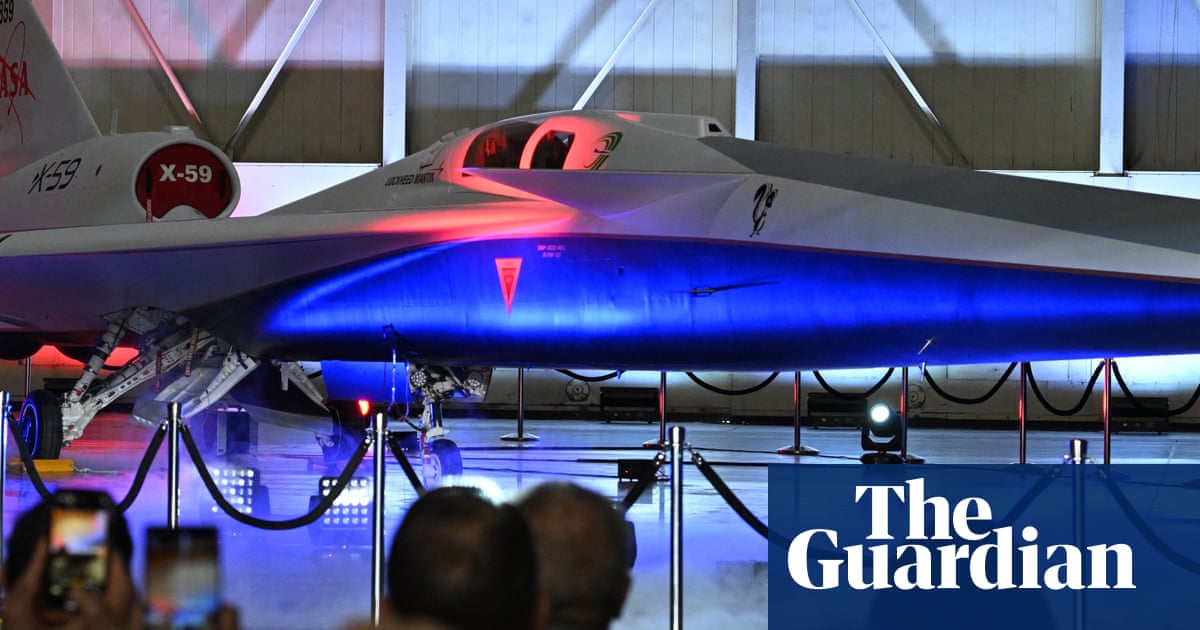- cross-posted to:
- [email protected]
- cross-posted to:
- [email protected]
In launch event on Friday, agency shared plans to test over US cities to see if it’s quiet enough by engaging ‘the people below’
Nasa has unveiled a one-of-a-kind quiet supersonic aircraft as part of the US space agency’s mission to make commercial supersonic flight possible.
In a joint ceremony with Lockheed Martin Skunk Works in Palmdale, California, on Friday, Nasa revealed the X-59, an experimental aircraft that is expected to fly at 1.4 times the speed of sound – or 925mph (1,488 km/h).
The aircraft, which stands at 99.7ft (30.4 metres) long and 29.5ft wide, has a thin, tapered nose that comprises nearly a third of the aircraft’s full length – a feature designed to disperse shock waves that would typically surround supersonic aircraft and result in sonic booms.
pretty neat that the image of the plane for the article is shot from so close that you can only see 1/3 of it, but to be fair it does include the screens of people’s phones as they take a picture of the thing. kind of like going to a concert.
Haha I wonder about the ungodly amount of fuel it burns.
Saudi Arabia is going to love this news.
https://amp.theguardian.com/environment/2023/nov/27/revealed-saudi-arabia-plan-poor-countries-oil
The website blasted me in the ass with ads, while simultaneously begging for donations
Yeah but with the pictures on the phones, we actually end up with more picture per picture with this method.
Yo dawg, I heard you like pictures
It’s proportions make it hard to frame it for an article headline picture. This is cropped to show a colorful array of the fun parts: cockpit, landing gear engine intake with a clear X-59. It’s like trying to make a cover picture feature a pencil
https://www.youtube.com/watch?v=eC3Fl7Bt4qQ
Nasa has a video up now
Please don’t. We need to be reducing air travel, not increasing it. Go invent a quiet supersonic train or something.
the transatlantic railway is feeling less and less like a funny absurdist joke by the hour
Let’s get started on the Snowpiercer too
What is your plan for intercontinental travel? Increased ship travel, taking a week and burning massive amounts of crude fuel oil? Just cut off the Americas and Australia from Europe, Africa and Asia for non-commercial purposes? The supersonics have mostly been used for trans-atlantic and trans-pacific travel.
Less and more efficient airplanes. Supersonic aircraft will consume more fuel.
Let’s get weird with blimps
These kinds of comments only say it’s wrong; they never make a valid contribution to finding a solution.
The guy you’re replying to or the nonce suggesting we shelve all transportation technology and only use trains?
The nonce, of course.
Oh good, he has too many upvotes for me to assume but I figured.
It’s such a shame, you’d think these communities would be about how advancement is always good due to it unlocking new possibilities. For example, maybe this aircraft will open up doors in hypersonic flight that could be used to make more efficient SSTO model and get us less dependent on fossil fuels for chemical rockets via traditional means. Or allows materials science to make a leap forward that revolutionizes fusion.
To just say “why are we doing this?” Is an absolutely insane perspective for R&D and a fundamental misunderstanding of the way we develop technologies.
I think part of the issue is that the fine granularity of Lemmy (or the other place we don’t speak of) doesn’t lend easily to broader topics but instead seems to pull in “only THIS” or “only THAT” binary thinking. Only bikes or only trains or only trams doesn’t help when you need to cross continents.
sailing and solar power exists, and i’m pretty dang certain we could get an ocean liner to cross the atlantic in less than a week with modern tech. Also probably still less emissions than air travel considering how absurly much fuel that uses.
There is a reason the tall masted rigged ships disappeared for regular travel; most people don’t want to take a month to cross the ocean in close quarters. Cruise ships are the closest analog to a long haul jet, and are no better to twice as CO2 producing than the airline travel, and the fuel they burn is the lowest grade fuel oil with the worst additional pollution. If you are moving across the ocean, or even just traveling, most people won’t be able to pilot their own sailing yacht and take 15-30 days to do it.
That is not said often enough, thank you !
I’m trying to fight the downvoters, you were on -3 when I saw your comment.
Looks like it worked, thanks ! My turn now ^^
That’s called a hyperloop, nobody liked the idea.
I think the next innovation will be slow electric powered lighter than air travel. Airships may be the future.
That and these new supersonic planes, they’re already happening. Boom supersonic is currently testing their demonstration plane based on this nasa project.
That’s called a hyperloop, nobody liked the idea.
I think the next innovation will be slow electric powered lighter than air travel. Airships may be the future.
That and these new supersonic planes, they’re already happening. Boom supersonic is currently testing their demonstration plane based on this nasa project. Their next step is to build a supersonic business class jet.
Oh bug off! We need faster travel for a long time now!
Being self centered like this is why we’re screwing up our planet.
The planet is fine.
We’re in the middle of the 5th mass extinction, it’s caused by humans. Climate change is just now starting to actually take effect, and we’re locked into many decades of increased disasters and loss of habitable land as the population careens into absolutely record numbers. I could keep going.
The planet is fine though. It’s not the first extinsion, it’s not the last. All previous ones were caused by some type of living creature as well.
the planet is fine, sure, but do you want to live on the surface of venus? i would personally find that somewhat lethal and prefer being able to breathe the air without immediately dying from carbon monoxide poisoning
So that’s what you should talk about - you don’t care about the planet, you care about yourself. I don’t care how would you feel on the surface of the Venus, I want my fast planes!
need
We need faster travel?
Yes
i agree, we need to invest in more high speed railways
That too!
Now the fuel efficiency problem needs to be reckened with. The sonic boom was the main reason why supersonic planes were shelved but poor fuel efficiency was the other 800 pound gorilla in the room.
That’s what we really need right now. Faster air travel for fewer people.
But how else will the ultra-wealthy jet over to their summer homes in new Zealand when wet bulb temperatures exceed human survival in the Northern Hemisphere?
Looks to me like a climate change accelerator for rich people. Fewer people per flight, spending more fuel to go faster.
Pleas explain why you think either of those things are true.
Supersonic jets already exist and use dramatically more fuel to carry fewer passengers. Making them not work this way would be an amazing breakthrough that would have merited some mention in the article.
Because of the high fuel use and limited space, this technology will be only used by the ultra-wealthy and will considerably accelerate climate change. It is an absolutely disastrous use of public funds.
the coefficient of drag goes up exponentially the faster you go. As for fewer people, I used my eyes to see that there’s not a lot of room for passengers.
Not OP:
The more you try to fly faster through any fluid (like earth’s atmosphere) the more drag you face. Hence you need a lot more energy (orders of magnitude more, possibly exponentially more). This equates to more fuel burn.
Also since you are going supersonic… you really cannot build big. Also, these things are quite expensive to build, maintain and run. Hence only the top 1% of folk could afford to fly in these things.
I’m no expert but I’ll take a stab at it. The faster you go the more drag you get on the fuselage that would need to be compensated for with more fuel (unless some neat mechanic helps to mitigate that). Take a look at a conventional jet airplane and you’ll notice it’s capable of holding passengers from nose cone to tail reasonably well due to its cylindrical shape. The X-59’s design has some very interesting geometric features that would give less internal volume for passengers (unless it can be modified to improve for this).
If that’s not reasonable enough then just look at the kinetic energy equation, KE=1/2mv^2. Compared to a velocity of a jet airliner going at 900km/hr versus this plane’s Mach 1.4 (roughly 1500 km/hr) it takes roughly 2.78 times more energy to move a vehicle at that speed (not accounting for drag, energy efficiency, etc.). Is it worth spending roughly 2.78 times more fuel to get to a place 1.67 times faster?
Please explain why you don’t think either of those things are true.
well, that’s 5 answers and no reply from you, i assume you’re busy campaigning to ban short-haul flights?
I would be disappointed if the prototype isn’t nicknamed Pinocchio.
This is pretty amazing! This thing could take people from Los Angeles to NYC in 3 hours. The science behind the noise baffling is really cool.
Wouldn’t suborbital flight be a lot more fuel efficient?
Not likely. Jet engines are crazy efficient compared to rockets.
And as far as I know there are only 2 or 3 companies who are even attempting to make a fully reusable rocket, and it’s really hard.
(Those companies being SpaceX and Stoke aerospace, but Stoke is a long way off. Relativity space was going to do full reusability, but I think they dropped the plan.)
.
They are still in the prototype stage. If they can prove the physics on small planes, they can scale up for commercial ones.
They can’t scale up without scaling up their costs. Proving the physics is easy (because concorde already did some of the hard work). It’s quite challenging to convince anyone that this is nothing but posterity for rich people.
Pierce said the X-59’s job would be to “collect data from the people below, determine if that sonic thump is acceptable and then turn the data over to US and international regulatory authorities in hopes to then lift that ban”.
Why can’t commercial airlines fund the project, then? Why is NASA investing public money to deregulate private industry?
This is literally how every expensive R&D project gets done. Private companies won’t dump this kind of money into good R&D, but the government will because they don’t care about ROI.
.
This design may minimize the sonic boom, but that boom cannot be eliminated. “Artist’s impression” image shows … absolutely no room for passengers. This is a design test aircraft focused solely on minimizing shockwave noise. Any passenger plane based on this design is going to be very low capacity, and wholly unable to pull up to a jet bridge at any airport.
This is a technology demonstrator to understand the acoustics of sonic booms. Passenger versions would likely look very different, just incorporating the information gathered from this project.
Why, that is exactly what I said!
No, you said it wouldn’t work as a passenger aircraft. You sound like a naysayer.
Actually, a lot of people including me would naysay even if it is viable. Because this stuff is for rich wankers who don’t need another excuse to burn down planet earth in their search for the next money making scheme.
No, you said it wouldn’t work as a passenger aircraft.
I said no such thing. What I said was:
Any passenger plane based on this design is going to be very low capacity, and wholly unable to pull up to a jet bridge at any airport.
Any passenger plane based on this design is going to be very low capacity, and wholly unable to pull up to a jet bridge at any airport.
I was addressing this, that passenger designs based on this design may not look anything like this airplane. So the constraints of the demonstrator won’t necessaraly carry over to the actual vehicles.
In order to minimize sonic booms, the design must feature an incredibly long, thin nose. That’s what precludes such an aircraft from pulling up to a gate. There’s just not enough room.
If such a passenger plane goes into production, it would need to be hand in hand with airport redesign, and the aircraft would still have a low passenger capacity. Any passenger aircraft with a reasonable capacity would need to be enormous. It’s going to use more fuel to get to M1.4, which will still keep ticket prices high. That means these will be for wealthy people only, if they’re even economically feasible at all.
The concorde (or the knock off, i forget which) had a nose cone that moved, so something like that could be potentially designed for the new aircrafts design too
Please explain why you think that principles learned here cannot inform designs at scale. Do you think it’s the small size of the aircraft which reduces the sonic boom?
To be fair about the jet bridge thing, I’ve definitely been at some pretty major airports (read “SeaTac”) and gone out onto the concrete to board a small plane. The jet bridge is not a deal breaker
Look at boom spersonic’s jet designs: https://boomsupersonic.com/
They’ve already sold future planes to several airlines. It’s happening.












